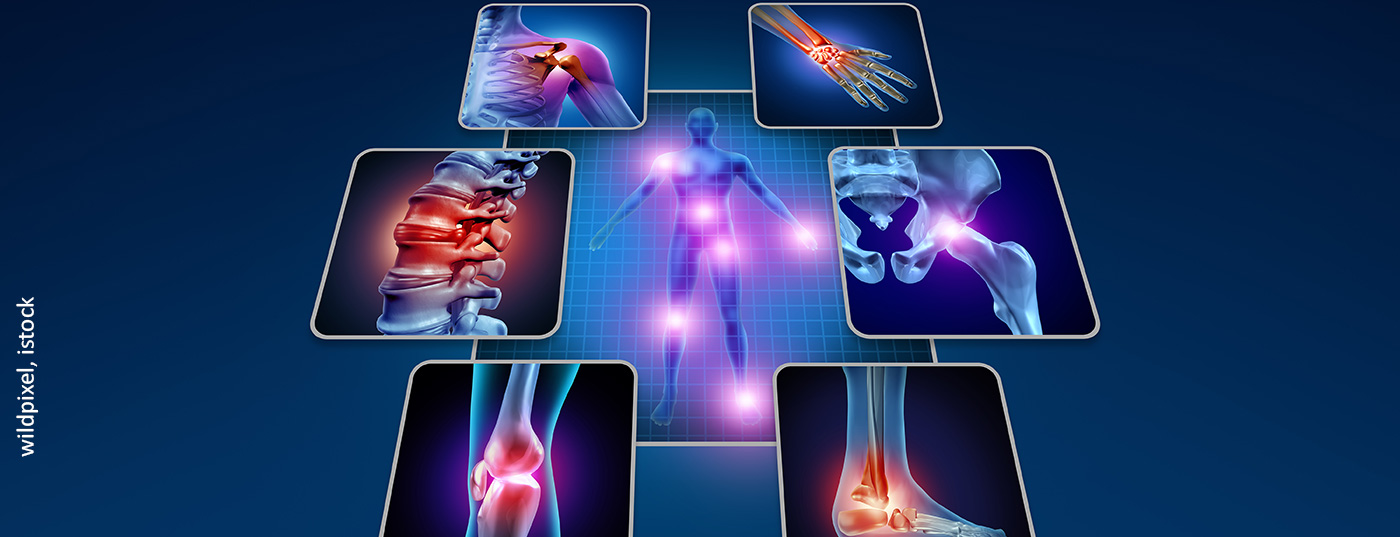Improving care in pain and palliative situations was the focus of this year’s Pain Congress. Patients with chronic pain in particular require individualized treatment in order to finally be able to live again. The fact that the typical patient is rarely addressed in current guidelines and basic research could be problematic, . Comprehensive knowledge transfer was therefore a top priority.
How is chronic pain defined in the first place? As Dr. med. Johannes Horlemann, Kevelaer (D), pointed out, these are the “six Ds”: Duration, Dramatization, Drugs, Despair, Disuse and Dysfunction. Accordingly, the pain has usually already lasted longer than six months, the presentation of the affected person is very expressive and emotional, medication use and/or alcohol use indicate permanent pain, despair, depressiveness, irritability and/or apprehension are recognizable, a protective posture is adopted and a social withdrawal has taken place. As an example of a typical sufferer, he presented a 69-year-old female patient, 169 cm tall, 96 kg and a housewife. She has been plagued with pain for over 20 years and presents due to polyarthrosis as well as lumbar spine syndrome. Primarily, she complains of difficulty walking and sitting up. The knees, hips, lumbar spine, cervical spine, shoulders and hands are affected. There is soft tissue swelling with hyperthermia and joint tenderness in the right knee. The pain radiates from the back to knee level with barely limited hip mobility. Neurological deficits are not detected. However, these or similar affected persons are hardly represented in the current study situation and thus also in valid guidelines. This makes real-world data such as the PraxisRegister Schmerz [1] all the more important.
Individual treatment thanks to real-world data
The PraxisRegister is the world’s largest pool of information about people with pain, with more than 250,000 treatment cases. This laid a foundation for needs-based health services research. Prof. Dr. med. Michael Überall, Nuremberg (D), brought current analyses regarding back pain. For 2019-2021, 1133 patients treated with muscle relaxants were detected. In fact, the largest proportion (90%) were sufferers with an acute pain status. In addition, with regard to severity, functional aspects were observed in 94.7%. The average treatment duration was correspondingly short at 12 days. Muscle pain in the low back/back, pelvis/legs, and shoulders/arms was predominantly treated. 91.9% then also received the recommended daily dose of one tablet of the muscle relaxant three times daily. At baseline, 64.5% of patients had pain intensity of ≥50 mm VAS. Median pain was 52.3 mm VAS. Therapy resulted in significant relief of symptoms to an average of 20.3 mm VAS. The proportion of patients who achieved a clinically relevant absolute pain improvement of at least 20 mm VAS was 94.4%. At median, this was 32.7 mm VAS. Relative relief of pain intensity with at least 50 mm VAS was achieved by 79.8%-an average of 61.9 mm VAS. Therapy was terminated individually when significant and adequate pain relief was perceived by the patient. This included improvement in pain-related impairment in daily living (mPDI). Here, 88.1% showed an absolute change of at least 20 mm VAS (mean 34.7 mm VAS). In addition, a correlation of pain relief and functional improvement was demonstrated. In fact, 100% reported an absolute change in pain intensity and 99.4% reported an improvement in terms of pain-related impairment. Furthermore, the therapy was very well tolerated. Adverse effects occurred in only 6.2%. These included predominantly headache, dizziness, nausea or circulatory reactions.
Pain as a common symptom of selected diseases
Small fiber neuropathies (SFN) are characterized by reduced intraepidermal nerve fiber density and functional disruption of C and Aδ nerve fibers [2]. Pain can often be detected as the main symptom, reported Dr. med. Maike Dohrn, Aachen (D). For the diagnosis, questionnaires are used, among other things, to be able to accurately determine the load, the area and the course of the pain. A clinical neurological examination, quantitative sensory testing, and skin biopsy follow. The causes of the disease range from impaired glucose tolerance and diabetes mellitus to vitamin B12 deficiency and autoimmune or infectious diseases. Up to 70% of cases are idiopathic in origin. Nevertheless, it is important to also consider rare but treatment-emergent hereditary differentials such as Fabry disease or transthyretin amyloidosis.
Inflammatory rheumatic diseases (ERE) were discussed as another disease with main symptom pain. These can be divided into rheumatoid arthritis, ankylosing spondylitis or fibromyalgia syndrome, among others. As Prof. Dr. med. Markus Gaubitz, Münster (D), reported, the pain therapist should also have an insight here, since often the affected persons do not yet have a rheumatism diagnosis. The pain usually occurs mainly in the morning – regardless of stress. Glucocorticoid therapy with prednisone or prednisolone is considered the treatment of choice for pain in ERE. However, if possible, this should not be used before the diagnosis is confirmed. Analgesics are predominantly used for relapses or additional causes of pain. It should be kept in mind that a high pain burden in ERE patients often implies an incorrect or additional diagnosis.
Cannabis in pain management
The influence of cannabinoids in medicine has increased in recent years. They are used primarily for chronic pain – especially neuropathic pain and in combination with opioids – spasticity of various genesis, appetite deficiency, nausea and vomiting of various genesis, refractory complaint combination of pain, nausea, appetite deficiency, anxiety and reactive resignation, and in complex palliative situations. According to one study, two-thirds of sufferers actually benefit from cannabinoid therapy [3]. With over 10,000 records evaluated, pain improved in 70% and spasticity improved in 84% of those affected. In 14% of users, the effect was rated as insufficient. In principle, the treatment seems to be well tolerated. Nevertheless, especially in the case of existing cardiovascular diseases, impaired liver or kidney function, and in patients of advanced age or children and adolescents, administration should only take place after a careful risk-benefit assessment and then with careful titration and close monitoring, explained Sven Gottschling, MD, Homburg/Saar (D). The golden rule is therefore also: “Start low, go slow, stay low”.
Have spine surgery indication confirmed
Spine surgery is becoming more common. According to a systematic survey, there is a striking discrepancy between the medically reasonable need and the interventions actually realized [4]. Nor can we speak of a long-term recovery. Often, patients can only be helped to a small extent and in the short term. In a second opinion concept, it was elicited that in 7565 patients, surgery could be confirmed as appropriate in only 4.9% of those affected. In 58.4%, high-intensity individualized outpatient multimodal pain therapy (MMST) appeared more targeted. This resulted in highly significant relief of pain from an initial 48.9 ± 16.5 mm to 26.3 ± 18.4 mm on the visual analog scale (VAS). Prof. Überall therefore advocates interdisciplinary evaluation and multimodal treatment concepts for patients with chronic low back pain.
Congress: German Pain and Palliative Day
Literature:
- Überall MA, Müller Schwefe GHH, Horlemann J: Pain Medicine 2018; 34(5): 64-73.
- Devigili G, Tugnoli V, Penza P, et al: Brain 2008; 131: 1912-1325.
- Schmid-Wolf G, Cremer-Schaeffer P: Bundesgesundheitsblatt 2021; 64: 368-377.
- Everywhere MA: Obtaining second opinions from pain-related spine surgery, Medicine Today 2022; 1: 16-17.
InFo PAIN & GERIATry 2022; 4(1-2): 32-33.











